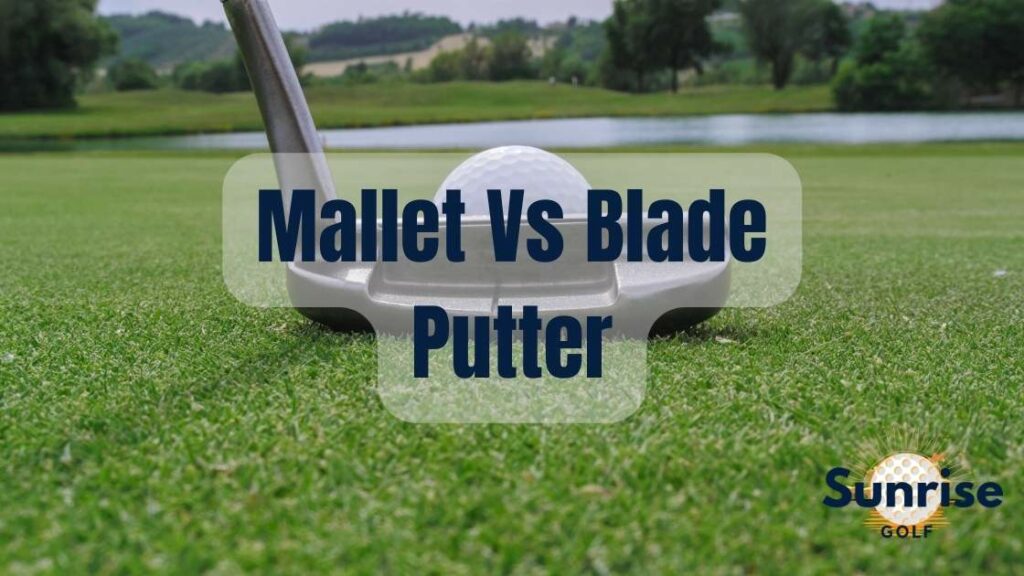Are you looking to improve your golf game and shave strokes off your scorecard? The right putter can make all the difference. As the old adage goes, “Drive for show, putt for dough.” With so many options available, the debate between mallet vs blade putter can be daunting. But fear not – we’re here to help you navigate the world of putters and make an informed decision that will have you sinking more putts in no time.
In this comprehensive guide, we’ll explore the differences between mallet vs blade putter, the preferences of professional and amateur golfers, the importance of stroke types in putter selection, and factors to consider when choosing the right putter for your game. So, let’s dive in and find the perfect putter to elevate your golf game to new heights!
Get ready to improve your putting performance and experience the freedom of finding the perfect putter for you.
Advantages of a Mallet Putter
One of the benefits of a mallet putter is that it provides more stability during the putting stroke. The larger, more weighted head of a mallet putter helps to minimize twisting and turning during your stroke, giving you a smoother and more controlled motion. This stability is especially beneficial for those who struggle with a shaky or inconsistent putting stroke.
When you’re out on the green, you want a putter that you can rely on to give you consistent results.
With a mallet putter in your hands, you can feel confident in your ability to make accurate putts and improve your overall performance on the greens.
A mallet putter is like the SUV of the putting world. It offers stability, especially during your putting stroke. The larger, weighted head minimizes twists and turns, providing a smoother motion. This is particularly useful if you find your hands shaking or your stroke wobbling.
Top 3 Mallet Putters:
- Scotty Cameron Special Select Putter: A premium option that offers superior balance and high-MOI performance.
- Odyssey White Hot OG Putter: Known for its exceptional feel and stability. The White Hot insert is iconic for a reason.
- TaylorMade Spider X Putter: Features a redesigned head for improved stability and alignment. Great for those looking for a modern look.
Advantages of a Blade Putter
A blade putter is the classic sports car of putters. It’s sleek, offers enhanced feel, and is highly maneuverable.
The slim profile and traditional look give it an air of elegance, while the direct clubface-to-ball connection allows for precise adjustments.
The blade putter is a classic choice that offers several benefits.
- Sleek and compact design: It has a slim profile and a traditional look that exudes elegance and simplicity.
- Enhanced feel and feedback: The blade putter provides a more direct connection between the clubface and the ball, allowing you to better gauge your stroke and make precise adjustments.
- Increased versatility: Due to its smaller head, the blade putter offers greater maneuverability, making it easier to navigate tricky greens and execute delicate shots.
These advantages make the blade putter a popular choice among golfers who value control, precision, and a traditional aesthetic.
Top 3 Blade Putters
- Scotty Cameron Newport Putter: Offers a blend of modern technology with traditional design, making it a favorite among pros.
- Cleveland Huntington Beach Putter: Known for its soft feel and precision, this putter is a great budget-friendly option without compromising on performance.
- Odyssey Triple Track Putter: Features unique alignment aids to help you line up your putts more accurately.
Key Differences Between Mallet and Blade Putters
The main distinction between mallet and blade putters is their design and performance.
Mallet putters have a larger, more forgiving head shape, often resembling a mallet or a spaceship. This design provides stability and helps to reduce twisting on off-center hits, making it easier to achieve consistent distance and direction control.
On the other hand, blade putters have a traditional, compact head shape, resembling a blade or a dagger. This design allows for greater feel and feedback, making it popular among golfers who prefer a more traditional look and want maximum control over their putting stroke.
Here’s a quick comparison of the key differences between mallet and blade putters:
| Mallet Putter | Blade Putter |
|---|---|
| Larger head size | Compact head size |
| Increased forgiveness | Enhanced feel and feedback |
| More stability on off-center hits | Greater control over putting stroke |
Ultimately, the choice between mallet and blade putters comes down to personal preference and individual putting style. So, whether you value forgiveness or feel, the decision is yours to make based on your own freedom on the greens.
Factors to Consider When Choosing Between a Mallet and Blade Putter
When deciding between a mallet and blade putter, it’s important to consider factors such as personal preference, putting style, and desired performance. These factors can greatly impact your putting game and ultimately determine which type of putter suits you best.
Personal preference: Do you prefer the feel of a heavier putter or a lighter one? This can affect your stroke and overall control on the greens.
Putting style: Are you more of a straight-back-straight-through putter or do you have an arcing stroke? Different putters are designed to accommodate different stroke styles.
Desired performance: Are you looking for more forgiveness on mishits or do you prioritize feedback and control? Mallet putters tend to be more forgiving, while blade putters offer more feel and precision.
Considering these factors will help you make an informed decision and choose the putter that aligns with your individual needs and preferences.
Tips for Improving Putting Performance With a Mallet or Blade Putter
You’ve made your pick – now it’s time to up your putting game:
- Alignment Matters: Whether mallet or blade, proper alignment is crucial. Mallets with alignment aids or blades with clear sightlines are your allies.
- Consistency is Key: Mallets demand a smooth, pendulum-like stroke. Utilize that larger head for stability. Blades? Focus on a slight arc or a straight-back, straight-through motion.
Is it easier to putt with a blade or mallet?
The preference for putting with a blade or mallet putter varies among golfers, and there is no definitive answer as to which one is easier.
Some golfers find it easier to putt with a blade putter due to its smaller and more traditional shape, which allows for a better feel and control.
On the other hand, others prefer the larger and more forgiving design of a mallet putter, which can provide more stability and alignment assistance.
Ultimately, it depends on personal preference, feelings, and the individual’s stroke. It is recommended to try out both types of putters and see which one feels more comfortable and produces better results for each golfer.
Final Thoughts
In conclusion, when deciding between a mallet putter and a blade putter, it ultimately comes down to personal preference and putting style.
Both options have their own benefits and advantages.
- The mallet putter offers stability and forgiveness, like a sturdy ship sailing through rough waters.
- On the other hand, the blade putter provides a traditional and precise feel, like a skilled surgeon’s scalpel.
Consider your own preferences, stroke type, and the greens you typically play on when making your decision. Remember, practice and technique are crucial to improving your putting performance, regardless of the putter you choose.
Frequently Asked Questions
Do pros use mallets or blades?
Both mallet and blade putters are used by professional golfers, with the majority of the world’s top 50 players favouring mallet putters. However, some prefer blade putters as they provide greater precision and control while others opt for mallets due to their increased stability and forgiveness.
Are mallets more forgiving than blades?
Mallet putters are generally more forgiving than blade putters, as they have a larger sweet spot and a more stable design. Blade putters can be less forgiving on off-center hits due to their smaller sweet spot and weight distribution, making mallets the better option for those looking for forgiveness.
What is the difference between a blade and a mallet putter?
Blade putters have a thin, flat head with a small sweet spot, while mallet putters have a large, rounded head shape and a big sweet spot, as well as alignment aids for better accuracy.
How do you swing a mallet putter?
To swing a mallet putter, use a straight back and through stroke to ensure the head is balanced. Place one hand on your abdomen to keep your body still and quiet for an accurate strike of the ball.
Which putter is better for golfers with a square-to-square stroke?
For golfers with a square-to-square stroke, mallet putters are the recommended choice due to their construction providing consistency and accuracy throughout the stroke.

